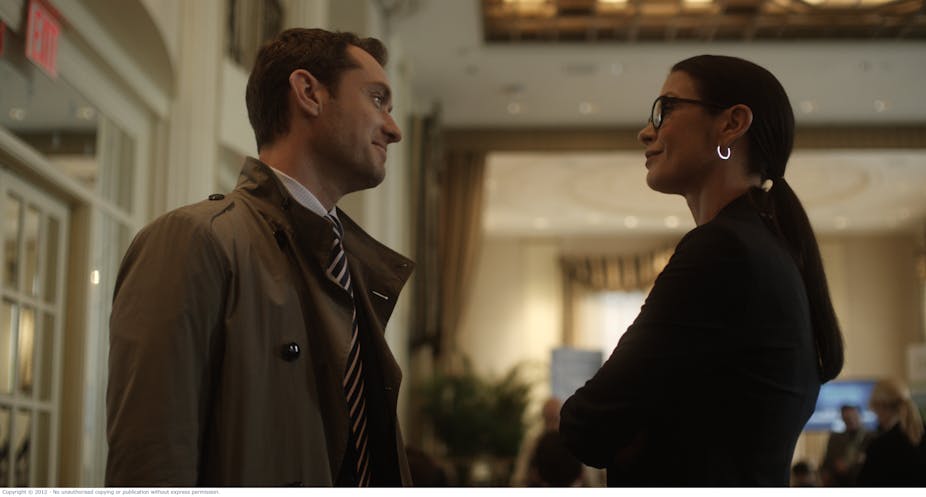When a drug returns more than a billion dollars in sales, it hits blockbuster status. So, notching up over US$11 billion in 2011 antidepressants are bona fide showstoppers. But these little pills have truly arrived now, starring in their very own Hollywood thriller.
Side Effects, director Steven Soderbergh’s cinematic swan song, charts the gradual unhinging of Emily Taylor (Rooney Mara). Husband Martin (Channing Tatum) has just emerged from a four-year prison stretch for insider trading.
The reunion is joyous, but bleak clouds soon gather and Emily’s world crumbles. This is not Emily’s first taste of psychic anguish. She sought counsel from Dr Victoria Siebert (Catherine Zeta-Jones) after Martin’s initial imprisonment.
Emily is finally pushed to the wall – literally – and lands in an emergency department. Her physical injuries are trivial, but psychiatrist Dr Jonathan Banks (Jude Law) worries Emily is on the low road to nowhere. The upshot is a diagnosis of depression and, you guessed it, the ubiquitous script for antidepressants.
The plot then borrows from almost every chapter in the psychiatric ethics textbook. As the title makes plain, Emily draws the short straw in the side-effect stakes. Parasomnias – unusual behaviour while asleep – are associated with a range of medications, including antidepressants. For Emily, a bout of sleep-capsicum-slicing takes a murderous, if improbable turn, when she puts her kitchen knife to an alternative use.
Enter moral conundrum number one. Is Emily a murderess? If, as seems the case, a crime was committed while asleep, can we adduce the mens rea, or intent necessary to ascribe guilt? Or is Dr Banks culpable here? After all, he persisted with the medication, even though aware of an earlier somnambulist incident. The media gets hold of the story and Banks’ life slowly unravels.
The movie faithfully renders the entrenched role of antidepressants in the United States and, increasingly, the developed world. Emily’s boss mentions her brush with them, as does a friend who even recommends her own brand.
The milieu is one of biological materialism, or the reduction of psychological symptoms to a question of deranged biochemistry. Depression is portrayed as a “flaw in chemistry not character”. In fact, Emily has good reason to be depressed. But in shooting from the hip with drugs, and making a decidedly pedestrian effort to explore life events, Dr Banks is a plausible Dr Everyman.

The spectre of Big Pharma looms large. A lavish lunch, courtesy of a drug company rep, lands Banks a lucrative recruiting role for a new anxiety drug trial. Ministering to a patient with anxiety, the good doctor studiously declares his conflict of interest. But the lure of “free meds” to join the trial is overwhelming, and the research subject is bagged.
The pitfalls of combining therapeutic obligations with the promise of Pharma coin are well described and have been chillingly dissected by bioethicist Carl Elliot. Patients are squeezed in a pharma sandwich, pressured on one side by physicians with big money riding on drug companies, and subtly cajoled on the other by direct-to-consumer advertising of prescription drugs (DTCA).
An antidepressant commercial for Emily’s drug Ablixa delivers the stock formula. Moody music, downcast woman, then a catchy exhortation to “take back your life from depression”. Presto, the rising tones of joy as mother strokes daughter’s hair in a verdant lakeside setting thanks, of course, to Ablixa. In fact, the ad is not only a brilliant replica of DTCA but was, perhaps a little cynically, released as part of the film’s sophisticated marketing.
But the ethics of pharmaceutical advertising is no laughing matter. It’s well known that positive imagery and music can induce favourable attitudes towards a product. Our research team has recently amassed evidence that such evaluative conditioning leads to stronger beliefs about drug effectiveness in DTCA. Despite the potency of imagery and music in DTCA, this content remains largely unregulated by the US Food and Drug Administration.
Serious consideration of the ethics of antidepressant use is, inevitably, set aside by the imperatives of hard business and a crowd-pulling plotline. All is not as it seems, so much of the moral scalp scratching becomes moot.
Don’t get me wrong. Catherine Zeta-Jones is unnerving, if falling short of the bunny-boiling heights of Glenn Close in Fatal Attraction. And Jude Law is a cracking shrink, even if his slide to ignominy could have been more emphatic than a perfunctory two-day growth and faded T-shirt under his designer jacket.
But there’s a nagging dissatisfaction that the ethics of antidepressant use, including the pressures of drug advertising and doctors in the pocket of Big Pharma, are never properly explored. But that, as they say, is Hollywood.

